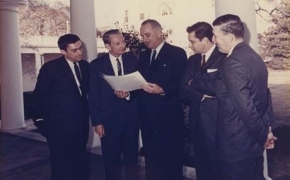Permanent Reauthorization of Land and Water Conservation Fund Serves As Milestone in Henry Diamond’s Legacy
On March 12, President Trump permanently signed into law a broad public lands package that permanently reauthorized the Land and Water Conservation Fund (LWCF), which has funded the protection of some of the most iconic U.S. landscapes from Cape Cod National Sea Shore to Point Reyes and Redwood National Park in California. Investing earnings from offshore oil and gas leasings rather than using taxpayer dollars, the program has generated over $18 billion for land conservation since its inception and funded land protection in all 50 states and at the federal level.
B&D co-founder Henry Diamond was an early architect of this program and worked tirelessly over several decades to preserve, permanently authorize, and fully fund LWCF. Working under Laurence Rockefeller, he served as editor of the final report of the Outdoor Recreation Resources Review Commission (ORRRC) delivered to President Kennedy and Congress in January 1962. Based on the ORRRC’s recommendations, the Kennedy Administration introduced funding legislation in 1962 and again in 1963 to establish a "Land and Water Conservation Fund." On September 3, 1964, President Johnson signed the Land and Water Conservation Fund Act into law to fulfill a bipartisan commitment to safeguard our natural areas, water resources, and cultural heritage, and to provide recreation opportunities to all Americans.
Congress initially authorized the law for a 25-year period and later extended LWCF for another 25 years, allowing the program to expire in September 2015 and again in 2018 following a temporary extension via the 2016 Consolidated Appropriations Act. In February 2019, after years of advocacy from diverse conservation and outdoor recreation groups, the Senate and House voted overwhelmingly (92-8 and 363-62) to pass the "John D. Dingell, Jr. Conservation, Management, and Recreation Act" (S. 47) that permanently authorized LWCF.
LWCF, authorized up to $900 million, remains the principal source of funding for federal land acquisition and conservation with support to programs in all fifty states as well. Budget battles over full funding for LWCF may continue, but we are proud to note that Henry’s conservation legacy will live on as the program he helped shape is now permanently authorized for the first time in its history.








